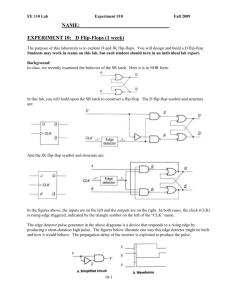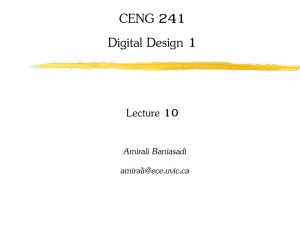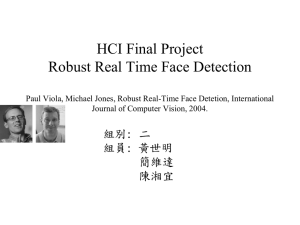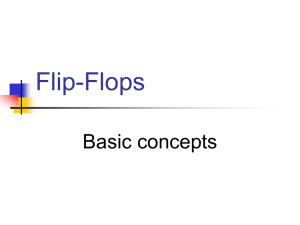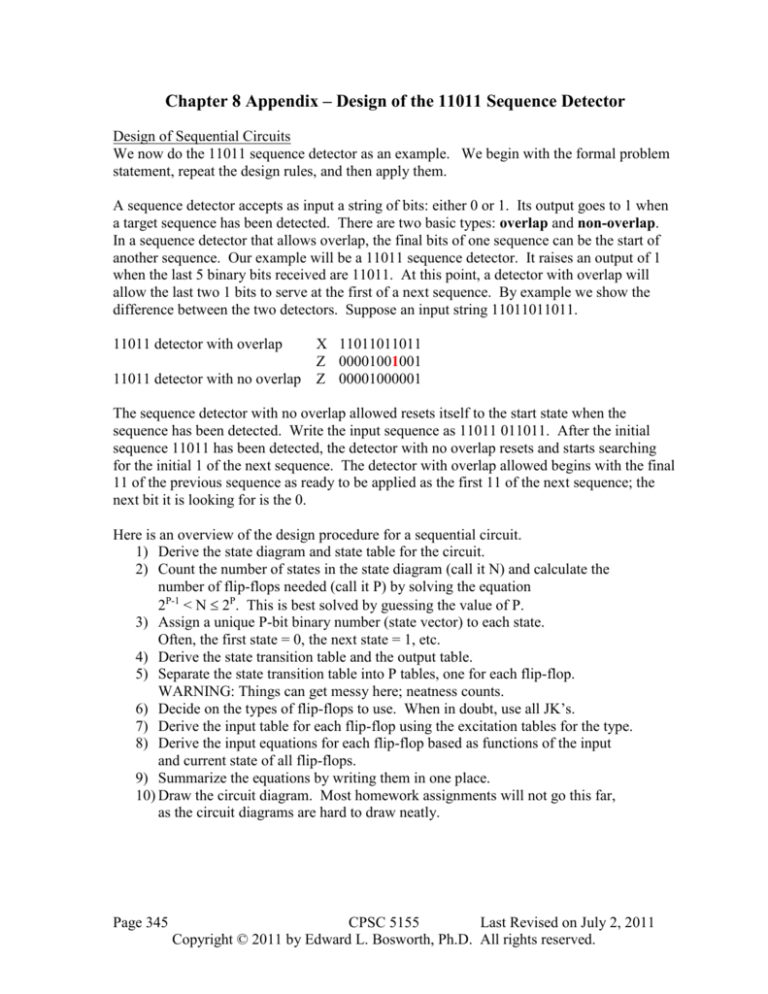
Chapter 8 Appendix – Design of the 11011 Sequence Detector
Design of Sequential Circuits
We now do the 11011 sequence detector as an example. We begin with the formal problem
statement, repeat the design rules, and then apply them.
A sequence detector accepts as input a string of bits: either 0 or 1. Its output goes to 1 when
a target sequence has been detected. There are two basic types: overlap and non-overlap.
In a sequence detector that allows overlap, the final bits of one sequence can be the start of
another sequence. Our example will be a 11011 sequence detector. It raises an output of 1
when the last 5 binary bits received are 11011. At this point, a detector with overlap will
allow the last two 1 bits to serve at the first of a next sequence. By example we show the
difference between the two detectors. Suppose an input string 11011011011.
11011 detector with overlap
11011 detector with no overlap
X 11011011011
Z 00001001001
Z 00001000001
The sequence detector with no overlap allowed resets itself to the start state when the
sequence has been detected. Write the input sequence as 11011 011011. After the initial
sequence 11011 has been detected, the detector with no overlap resets and starts searching
for the initial 1 of the next sequence. The detector with overlap allowed begins with the final
11 of the previous sequence as ready to be applied as the first 11 of the next sequence; the
next bit it is looking for is the 0.
Here is an overview of the design procedure for a sequential circuit.
1) Derive the state diagram and state table for the circuit.
2) Count the number of states in the state diagram (call it N) and calculate the
number of flip-flops needed (call it P) by solving the equation
2P-1 < N 2P. This is best solved by guessing the value of P.
3) Assign a unique P-bit binary number (state vector) to each state.
Often, the first state = 0, the next state = 1, etc.
4) Derive the state transition table and the output table.
5) Separate the state transition table into P tables, one for each flip-flop.
WARNING: Things can get messy here; neatness counts.
6) Decide on the types of flip-flops to use. When in doubt, use all JK’s.
7) Derive the input table for each flip-flop using the excitation tables for the type.
8) Derive the input equations for each flip-flop based as functions of the input
and current state of all flip-flops.
9) Summarize the equations by writing them in one place.
10) Draw the circuit diagram. Most homework assignments will not go this far,
as the circuit diagrams are hard to draw neatly.
Page 345
CPSC 5155
Last Revised on July 2, 2011
Copyright © 2011 by Edward L. Bosworth, Ph.D. All rights reserved.
Chapter 8 Appendix
Boz–7
Design of a 11011 Sequence Detector
Problem: Design a 11011 sequence detector using JK flip-flops. Allow overlap.
Step 1 – Derive the State Diagram and State Table for the Problem
The method to be used for deriving the state diagram depends on the problem. I show the
method for a sequence detector. At this point in the problem, the states are usually labeled
by a letter, with the initial state being labeled “A”, etc.
Step 1a – Determine the Number of States
It can be proven that an N-bit sequence detector requires at least N states to function
correctly. It can also be shown that a circuit with more than N states is unnecessarily
complicated and a waste of hardware; thus, an N-bit sequence detector has N states.
We are designing a sequence detector for a 5-bit sequence, so we need 5 states. We label
these states A, B, C, D, and E. State A is the initial state.
Step 1b – Characterize Each State by What has been Input and What is Expected
State
Has
Awaiting
A
-11011
B
1
1011
C
11
011
D
110
11
E
1101
1
Step 1c – Do the Transitions for the Expected Sequence
Here is a partial drawing of the state diagram. It has only the sequence expected. Note that
the diagram returns to state C after a successful detection; the final 11 are used again.
Note the labeling of the
transitions: X / Z. Thus
the expected transition
from A to B has an input
of 1 and an output of 0.
B
1/0
1/0
A
C
1/1
E
0/0
The transition from E to
C has an output of 1
denoting that the desired
sequence has been
detected.
D
1/0
Page 346
CPSC 5155
Last Revised on July 2, 2011
Copyright © 2011 by Edward L. Bosworth, Ph.D. All rights reserved.
Chapter 8 Appendix
Boz–7
Design of a 11011 Sequence Detector
Step 1d – Insert the Inputs That Break the Sequence
Each state has
two lines out
of it – one
line for a 1
and another
line for a 0.
The notes
below explain
how to handle
the bits that
break the
sequence.
A State A is the initial state. It is waiting on a 1. If it gets a 0, the machine remains
in state A and continues to remain there while 0’s are input.
B If state B gets a 0, the last two bits input were “10”. This does not begin the
sequence, so the machine goes back to state A and waits on the next 1.
C If state C gets a 1, the last three bits input were “111”. It can use the last two
of these 1’s to be the first two 1’s of the sequence 11011, so the machine stays
in state C awaiting a 0. We might have something like 1111011, etc.
D If state D gets a 0, the last four bits input were 1100. These 4 bits are not part of
the sequence, so we start over.
E If state E gets a 0, the last five bits input were 11010. These five bits are not part of the
sequence, so start over.
More precisely we should be discussing prefixes and suffixes. At state C with input 111, the
two bit suffix to the sequence input is 11 which is a two bit prefix of the desired sequence, so
we stay at C. At E, getting a sequence 11010, we note that the 1–bit suffix is a 0, which is
not a prefix of the desired sequence; the 2–bit suffix is 10, also not a prefix, etc.
Step 1e – Generate the State Table with Output
Present State
A
B
C
D
E
Page 347
X=0
A/0
A/0
D/0
A/0
A/0
Next State / Output
X=1
B/0
C/0
C/0
E/0
C/1
CPSC 5155
Last Revised on July 2, 2011
Copyright © 2011 by Edward L. Bosworth, Ph.D. All rights reserved.
Chapter 8 Appendix
Boz–7
Design of a 11011 Sequence Detector
Step 2 – Determine the Number of Flip-Flops Required
We have 5 states, so N = 5. We solve the equation 2P-1 < 5 2P by inspection, noting that it
is solved by P = 3. So we need three flip-flops.
Step 3 – Assign a unique P-bit binary number (state vector) to each state.
The simplest way is to make the following assignments
A = 000
B = 001
C = 010
D = 011
E = 100
Occasionally, a better assignment can be detected by inspection of the next state table. I note
that the next states in the table cluster into two disjoint sets for X = 0 and X = 1.
For X = 0 the possible next states are A and D
For X = 1 the possible next states are B, C, and E.
For this reason, I elect to give even number assignments to states A and D, and to give odd
number assignments to states B, C, and E. Being somewhat traditional, I want to assign the
state numbers in increasing order so that we don’t get totally confused. The assignment is
A = 000
B = 001
C = 011
Note that states 010, 110, and 111 are not used.
D = 100
E = 101
Step 4 – Generate the Transition Table With Output
Note that in many designs, such as counters, the states are already labeled with binary
numbers, so the state table is the transition table. We shall label the internal state by the three
bit binary number Y2Y1Y0 and use the three-bit vectors defined above.
Present State
A
B
C
D
E
Page 348
Y2Y1Y0
0 0 0
0 0 1
0 1 1
1 0 0
1 0 1
Next State / Output
X=0
X=1
Y2Y1Y0
0 0 0
0 0 0
1 0 0
0 0 0
0 0 0
/
/
/
/
/
/
Z
0
0
0
0
0
Y2Y1Y0
0 0 1
0 1 1
0 1 1
1 0 1
0 1 1
/
/
/
/
/
/
Z
0
0
0
0
1
CPSC 5155
Last Revised on July 2, 2011
Copyright © 2011 by Edward L. Bosworth, Ph.D. All rights reserved.
Chapter 8 Appendix
Boz–7
Design of a 11011 Sequence Detector
Step 4a – Generate the Output Table and Equation
The output table is generated by copying from the table just completed.
Present State
Y2Y1Y0
0 0 0
0 0 1
0 1 1
1 0 0
1 0 1
X=0
0
0
0
0
0
0
The output equation can be obtained from inspection.
As is the case with most sequence detectors, the
output Z is 1 for only one combination of present state
and input. Thus we get Z = X Y2 Y1’ Y0.
X=1
0
0
0
0
0
1
This can be simplified by noting that the state 111 does
not occur, so the answer is Z = X Y2 Y0.
Step 5 – Separate the Transition Table into Three Tables, One for Each Flip-Flop
We shall generate a present state / next state table for each of the three flip-flops; labeled Y2,
Y1, and Y0. It is important to note that each of the tables must include the complete present
state, labeled by the three bit vector Y2Y1Y0.
Y2
PS
Y2Y1Y0
000
001
011
100
101
Match
Next State
X=0
X=1
0
0
0
0
1
0
0
1
0
0
Y1
Y2Y0’
Y1
PS
Y2Y1Y0
000
001
011
100
101
Next State
X=0
X=1
0
0
0
1
0
1
0
0
0
1
0
Y0
Y0
PS
Y2Y1Y0
000
001
011
100
101
Next State
X=0
X=1
0
1
0
1
0
1
0
1
0
1
0
1
Before trying step 6, I shall note a quick, but often messy, implementation. We look at an
implementation using D flip-flops only. For each flip-flop, we have the desired next state for
each combination of present state and input. Remember that the D flip-flop equation is
D = Q(T + 1); i.e., input to the flip-flop whatever the next state is to be. Thus, this design is
D2
D1
D0
= X’Y1 + XY2Y0’
= X Y0
=X
While this may be an acceptable implementation, it is important to complete the original
design problem using JK flip-flops. What we want is input equations for J2, K2, J1, K1,
J0, and K0. Inspection of the above gives little clue for the first two flip-flops, but any
student recalling the use of a JK flip-flop to implement a D flip-flop will see immediately
that the input equation for flip-flop 0 is J0 = X and K0 = X’.
Step 6 – Decide on the type of flip-flops to be used.
The problem stipulates JK flip-flops, so we use them. As an aside, we examine the
difficulties of designing the circuit with D flip-flops.
Page 349
CPSC 5155
Last Revised on July 2, 2011
Copyright © 2011 by Edward L. Bosworth, Ph.D. All rights reserved.
Chapter 8 Appendix
Boz–7
Design of a 11011 Sequence Detector
Step 7 – Derive an Input Table for Each Flip-Flop using its Excitation Table
and
Step 8 – Produce the Input Equations for Each Flip-Flop
It is at this point that we first use the fact that we have specified JK flip-flops for the design.
We have already considered a D flip-flop implementation. Because we are using JK flipflops, we show the excitation table for a JK flip-flop.
Q(T) Q(T + 1)
0
0
0
1
1
0
1
1
J
0
1
d
d
K
d
d
1
0
We shall see shortly how the presence of the
d (Don’t Care) state simplifies design.
It is at this point that neatness counts. For each flip-flop we shall write out the complete
present state and the next state of the specific flip-flop. We then use the present state and
next state of the specific flip-flop to determine its required input. The problem here is
comparing the next state of the flip-flop to the correct present state.
Y2Y1Y0
Y2
0
0
1
0
0
000
001
011
100
101
X=0
J2
0
0
1
d
d
K2
d
d
d
1
1
Y2
0
0
0
1
0
X=1
J2
0
0
0
d
d
K2
d
d
d
0
1
First we do Y2.
Probably the easiest way to
generate this table is to do all
of the “0 to 0” transitions first,
then the “0 to 1”, etc. For this
flip-flop, be sure to refer back
to the Y2 part of the PS.
We now try to produce the input equations for J2 and K2 by simplifying the above columns.
The best way is to consider first the X = 0 columns, then the X = 1 columns and finally to
combine the two. There are formal ways to do this, but I try simple matching.
1) If a column has only 0 and d, it is matched by 0.
2) If a column has only 1 and d, it is matched by 1.
3) If this does not work, try a match to one of Y2, Y1, or Y0.
Remember, the d entries do not have to match anything.
Consider X = 0. In the above, for J2, we have only 001 as a real pattern. These copy the
pattern seen in Y1, so we make the assignment that for X = 0, J2 = Y1. For X = 0, the only
pattern seen is a pair of 1’s, so for X = 0 we set K2 = 1.
X=0
X=1
J2 = Y1
K2 = 1
J2 = 0
K2 = Y0
thus, J2 = X’Y1
thus, K2 = X’ + XY0 = X’ + Y0.
Note the combination rule X’(expression for X= 0) + X(expression for X = 1).
Applied to J2, the rule gives J2 = X’Y1 + X0 = X’Y1
The second simplification uses the absorption law: X’ + XY = X’ + Y for any X and Y.
Page 350
CPSC 5155
Last Revised on July 2, 2011
Copyright © 2011 by Edward L. Bosworth, Ph.D. All rights reserved.
Chapter 8 Appendix
Boz–7
Design of a 11011 Sequence Detector
We now derive the input equations for flip-flop 1.
Y2Y1Y0
000
001
011
100
101
Y1
0
0
0
0
0
X=0
J1
0
0
d
0
0
K1
d
d
1
d
d
Y1
0
1
1
0
1
X=1
J1
0
1
d
0
1
K1
d
d
0
d
d
The patterns are detected first for X = 0 and X = 1 separately and then combined.
X=0
X=1
J1 = 0
J1 = Y0
K1 = 1
K1 = 0
thus J1 = XY0 and K1 = X’.
We now derive the input equations for flip-flop 0.
Y2Y1Y0
000
001
011
100
101
Y0
0
0
0
0
0
X=0
J0
0
d
d
0
d
K0
d
1
1
d
1
Y0
1
1
1
1
1
X=1
J0
1
d
d
1
d
K0
d
0
0
d
0
The patterns are detected as above
X=0
X=1
J0 = 0
J0 = 1
K0 = 1
K0 = 0
thus J0 = X and K0 = X’, as expected.
Step 9 – Summarize the Equations
The purpose of this step is to place all of the equations into one location and facilitate
grading by the instructor. Basically we already have all of the answers.
Z = XY2Y0
J2 = X’Y1 and K2 = X’ + Y0
J1 = XY0 and K1 = X’
J0 = X and K0 = X’
Step 10 – Draw the Circuit
I usually do not ask for this step as it tends to be messy and is always hard to grade.
The figure on the next page has been added to show a typical drawing of this circuit as
implemented by JK flip-flops.
Page 351
CPSC 5155
Last Revised on July 2, 2011
Copyright © 2011 by Edward L. Bosworth, Ph.D. All rights reserved.
Chapter 8 Appendix
Boz–7
Design of a 11011 Sequence Detector
Here is the circuit for the 11011 sequence detector as implemented with JK flip-flops.
The equations implemented in this design are:
Z = XY2Y0
J2 = X’Y1
K2 = X’ + Y0
J1 = XY0
K1 = X’
J0 = X
K0 = X’
Here is the same design implemented with D flip-flops.
The equations for this design are
Page 352
D2
D1
D0
= X’Y1 + XY2Y0’
= X Y0
=X
CPSC 5155
Last Revised on July 2, 2011
Copyright © 2011 by Edward L. Bosworth, Ph.D. All rights reserved.
Chapter 8 Appendix
Boz–7
Design of a 11011 Sequence Detector
More on Overlap – What it is and What it is not
At this point, we need to focus more precisely on the idea of overlap in a sequence detector.
For an extended example here, we shall use a 1011 sequence detector.
The next figure shows a partial state diagram for the sequence detector. The final transitions
from state D are not specified; this is intentional.
Here we focus on state C and the X=0
transition coming out of state D. By
definition of the system states,
State C – the last two bits were 10
State D – the last three bits were 101.
If the system is in state D and gets a 0
then the last four bits were 1010, not
the desired sequence. If the last four
bits were 1010, the last two were 10 –
go to state C. The design must reuse
as many bits as possible.
Note that this decision to go to state C when given a 0 is state D is totally independent of
whether or not we are allowing overlap. The question of overlap concerns what to do
when the sequence is detected, not what to do when we have input that breaks the sequence.
Just to be complete, we give the state diagrams for the two implementations of the sequence
detector – one allowing overlap and one not allowing overlap.
The student should note that the decision on overlap does not affect designs for handling
partial results – only what to do when the final 1 in the sequence 1011 is detected.
Page 353
CPSC 5155
Last Revised on July 2, 2011
Copyright © 2011 by Edward L. Bosworth, Ph.D. All rights reserved.
Chapter 8 Appendix
Boz–7
Design of a 11011 Sequence Detector
Solved Problems
1. Construct a 1101 sequence detector using JK flip-flops.
a) This is a four state machine. You must label the states as
A, B, C, and D. Start at state A. Make the following assignments.
A
00
C
10
B
01
D
11
b) Follow my steps fairly closely. Be sure to group your answers
at the end of the problem so that I can find them.
c) The circuit diagram is optional.
CRITICISM: The problem does not specify whether or not overlap is allowed. This is a
serious omission, so I shall have to present two solutions and accept either one.
ANSWER: As requested of you, I shall follow the steps in my method fairly closely.
Step 1 – Derive the State Diagram and State Table for the Problem
Step 1a Determine the Number of States
This is a four-bit sequence detector, so the Finite State Machine (FSM) has four states.
As indicated in the assignment, we label the states as A, B, C, and D.
Step 1b Characterize Each State
State
Has Needs For overlap analysis, note the following
A --1101
B 1
101
1101 1101 1101
C 11
01
1101 1101 1101
D 110
1
OK
No Good
No Good
The overlap causes a return to state B.
Step 1c Do the Transitions for the Expected Sequence
Page 354
CPSC 5155
Last Revised on July 2, 2011
Copyright © 2011 by Edward L. Bosworth, Ph.D. All rights reserved.
Chapter 8 Appendix
Boz–7
Design of a 11011 Sequence Detector
Step 1d Insert the Inputs That Break the Sequence
State A needs a 1 to cause a transition to state B.
Given a 0 in state A, the FSM remains in state A.
State B has a 1 and needs a 1 to transition to state C.
If state B gets a 0, the last two bits input are 10 – not a part of the sequence.
Given a 0 in state B, the FSM returns to state A.
State C has the last two bits input as 11 and needs a 0 to transition to state D.
If state C gets a 1, the last three bits input are 111 and the last two input are 11.
Given a 1 in state C, the FSM remains in state C.
State D has the last three bits input as 110 and needs a 1 to complete the sequence.
If state D gets a 0, the last four bits input are 1100 – not a part of the sequence.
Given a 0 in state D, the FSM returns to state A.
The complete state diagram for the detector is thus the following.
Step 1e Generate the State Table with Output
PS
A
B
C
D
NS / Z
X=0
A/0
A/0
D/0
A/0
PS
X=1
B/0
C/0
C/0
A/1
Overlap Not Allowed
Page 355
A
B
C
D
NS / Z
X=0
A/0
A/0
D/0
A/0
X=1
B/0
C/0
C/0
B/1
With Overlap
CPSC 5155
Last Revised on July 2, 2011
Copyright © 2011 by Edward L. Bosworth, Ph.D. All rights reserved.
Chapter 8 Appendix
Boz–7
Design of a 11011 Sequence Detector
Step 2 – Determine the Number of Flip-Flops Required
Solve the equation 2P-1 < N 2P, for N = 4. It is seen by inspection that P = 2 is the solution
of this equation, as 2 < 4 4, or 21 < 4 22. We need two flip-flops.
Step 3 – Assign a Unique P-Bit Binary Number to Each State
As P = 2, we are to assign a unique 2-bit number to each state. The assignments specified in
the problem statement are A = 00, B = 01, C = 10, and D = 11. The flip-flops will be labeled
Y1 and Y0, so the state is labeled as Y1Y0.
Step 4 – Generate the Transistion Table with Output
PS
A
B
C
D
NS / Z
X=0
00 / 0
00 / 0
11 / 0
00 / 0
00
01
10
11
PS
X=1
01 / 0
10 / 0
10 / 0
00 / 1
A
B
C
D
Overlap Not Allowed
00
01
10
11
NS / Z
X=0
00 / 0
00 / 0
11 / 0
00 / 0
X=1
01 / 0
10 / 0
10 / 0
01 / 1
With Overlap
Step 4a – Generate the Output Table and Output Equation
This is the same for both the overlap and non-overlap case.
PS
Y1Y0
00
01
10
11
Z
X=0
0
0
0
0
X=1
0
0
0
1
The only output occurs when X = 1, Y1 = 1, and Y0 = 1.
The output equation is thus Z = X Y1 Y0, a product term.
Step 5 – Separate the Transition Table into Two Tables, One for Each Flip-Flop
Page 356
CPSC 5155
Last Revised on July 2, 2011
Copyright © 2011 by Edward L. Bosworth, Ph.D. All rights reserved.
Chapter 8 Appendix
Boz–7
Design of a 11011 Sequence Detector
Step 6 – Decide on the Type of Flip-Flops to Use
The problem specifies that JK flip-flops be used.
The table at right is the excitation table for a JK
flip-flop. We shall need to use the excitation table in
order to deduce the inputs to each flip-flop that will
make the circuit behave in the desired manner.
Q(T)
0
0
1
1
Q(T + 1)
0
1
0
1
J
0
1
d
d
Step 7 – Derive an Input Table for Each Flip-Flop
Here we shall do first the no-overlap case and then the overlap case.
Without Overlap
With Overlap
Note that only one entry is different here.
Page 357
CPSC 5155
Last Revised on July 2, 2011
Copyright © 2011 by Edward L. Bosworth, Ph.D. All rights reserved.
K
d
d
1
0
Chapter 8 Appendix
Boz–7
Design of a 11011 Sequence Detector
Step 8 – Produce the Input Equations for Each Flip-Flop.
What we are doing here is producing an equation that matches each 0 and 1 in a column. The
don’t-care conditions, signified by “d” in the columns, are ignored. We try matching in
increasing order of complexity. We must match to variables in the present state column.
1) The first try should be 0 or 1. If a column has no 1’s in it, it is matched by 0.
If the column has no 0’s in it, it is matched by 1.
2) We next try to match to simple variables or their complements.
3) The next step is combinations of the variables.
Step 8a – Produce the Equations for the X = 0 and X = 1 Parts of Each Flip-Flop
Step 8b – Use the “Combine Rule” to Produce the Equations
Without Overlap
For X = 0
For X = 1
J1 = 0 and K1 = Y0
J1 = Y0 and K1 = Y0
For X = 0 J0 = Y1
For X = 1 J0 = Y1’
and K0 = 1
and K0 = 1
Use the Combine Rule: Expression = X’(Expression for X = 0) + X(Expression for X = 1)
J1 = X’0 + XY0 = XY0
K1 = X’Y0 + XY0 = Y0
J0 = X’Y1 + XY1’ = X Y1
K0 = X’1 + X1 = X’ + X = 1
With Overlap
Note that only one entry is different. The Y0 table is different, the Y1 table is the same.
J1 = XY0
K1 = Y0
For X = 0 J0 = Y1 and K0 = 1
For X = 1 J0 = Y1’ and K0 = Y1’
Using the Combine Rule for J0 and K0, we get
J0 = X’Y1 + XY1’ = X Y1
K0 = X’1 + XY1’ = X’ + XY1’ = X’ + Y1’
We now prove the last equality for K0 – that X’ + XY1’ = X’ + Y1’.
Let X = 0. Then LHS = 0’ + 0Y1’ = 1 + 0 = 1 and RHS = 0’ + Y1’ = 1 + Y1’ = 1
Let X = 1. Then LHS = 1’ + 1Y1’ = Y1’ and RHS = 1’ + Y1’ = 0 + Y1’ = Y1’
Page 358
CPSC 5155
Last Revised on July 2, 2011
Copyright © 2011 by Edward L. Bosworth, Ph.D. All rights reserved.
Chapter 8 Appendix
Boz–7
Design of a 11011 Sequence Detector
Step 9 – Summarize the Equations
The output equation is Z = X Y1 Y0.
For the case with no overlap.
J1 = XY0
J0 = X Y1
K1 = Y0
K0 = 1
For the case with overlap allowed
J1 = XY0
J0 = X Y1
K1 = Y0
K0 = X’ + Y1’
Page 359
CPSC 5155
Last Revised on July 2, 2011
Copyright © 2011 by Edward L. Bosworth, Ph.D. All rights reserved.

